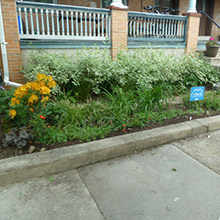Rain Gardens
What is a rain garden?
 |
Rain gardens are shallow, planted depressions that are designed to absorb water from your roof, allowing it to drain directly into the soil. Typically, a downspout from your home is disconnected from the sewer system and diverted into the rain garden, which can prevent hundreds of gallons per year from entering the City’s sewer system. Rain gardens are one of the most cost effective ways to manage stormwater runoff and can be a beautiful addition to your existing landscape design. Cost: Rain Check will contribute $16 per square foot towards your rain garden up to a maximum of $2000. At an average price of $17-$20 per square foot, this contribution often covers a very large percentage of the project. |
About our rain gardens:
- Before planting, we will perform an “infiltration test” at your home to make sure that your soil is well-suited for a rain garden.
- Rain gardens are excavated to a depth of 6” to 12”. Then, the garden is filled with a stormwater-friendly mix of soil, sand, and compost.
- All rain gardens are planted with native, drought-tolerant perennial species. These species do the best job of absorbing and filtering stormwater and are very low maintenance. Our rain gardens are planted with young specimens that will thrive over time. The rain gardens are designed to fill in completely over 1-3 growing seasons.
- Rain gardens must be planted in an area that is at least 10 feet from a below-ground basement.
- Rain gardens can create a habitat for butterflies and birds.
- Are you particular about your landscaping design choices? Our expert contractors will work with you to create a design that is appealing and unique to your property.
Rain garden maintenance:
|
 |
To get a rain garden installed at your home, click here to sign up for a Rain Check assessment.